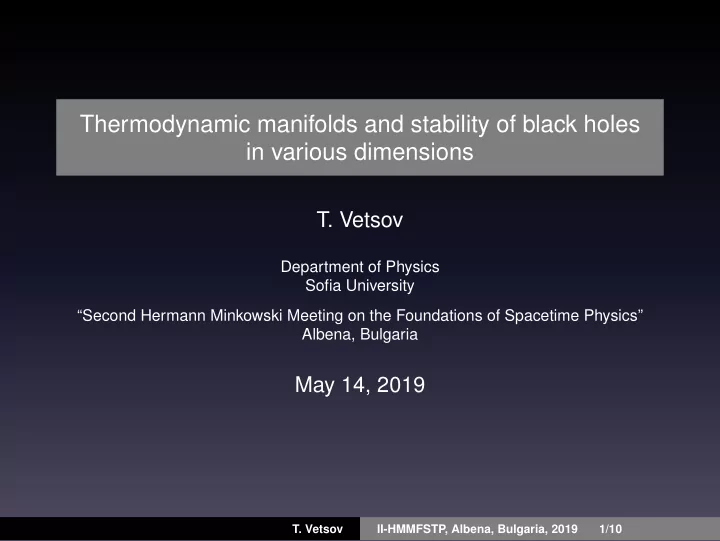

Thermodynamic manifolds and stability of black holes in various dimensions T. Vetsov Department of Physics Sofia University “Second Hermann Minkowski Meeting on the Foundations of Spacetime Physics” Albena, Bulgaria May 14, 2019 T. Vetsov II-HMMFSTP, Albena, Bulgaria, 2019 1/10
Black hole thermodynamics Black holes have entropy (Bekenstein-Hawking ’70s): A S = k B + corrections (1) 4 L 2 p The first law of thermodynamics: dM = TdS + Ω dJ + Φ dQ + · · · = TdS + Φ i dQ i = I a dE a (2) Black holes thermal stability (Davies ’80): > 0 , stable, C = T ∂S < 0 , radiating ( unstable ) , (3) = 0 , phase transitions, ∂T → ∞ , phase transitions T. Vetsov II-HMMFSTP, Albena, Bulgaria, 2019 2/10
Geometric approaches to the equilibrium space of black holes The space of extensive parameters E = { Ξ , E a } is called an equilibrium manifold if supplied with a proper metric structure. • Hessian information metrics, “Geometric thermodynamics” (F . Weinhold 1975, G. Ruppeiner 1979) • Legendre invariant metrics, “Geometrothermodynamics” (H. Quevedo 2006) • Method of conjugate potentials, “New geometric thermodynamics” (B. Mirza, A. Mansoori 2014 & 2019) T. Vetsov II-HMMFSTP, Albena, Bulgaria, 2019 3/10
Hessian metrics Fluctuation theory (G. Ruppeiner ’79): ∂ 2 S ∂E a ∂E b dE a dE b + · · · S ( E a ) = S 0 + EQL + = S 0 + EQL − g ab ( � E ) dE a dE b (4) Ruppeiner information metric: ∂ 2 S g ( R ) ∂E a ∂E b = − Hess S ( � = − E ) (5) ab Weinhold information metric (F . Weinhold ’75): ∂ 2 M g ( W ) ∂E a ∂E b = Hess M ( � = E ) (6) ab T. Vetsov II-HMMFSTP, Albena, Bulgaria, 2019 4/10
Scalar curvature and quantum gravity 1 The probability for fluctuating between two macro states is proportional to the geodesic distance between them in E . 2 The strength of interactions/correlations between quantum bits on the event horizon = the magnitude of R 3 The sign of R indicates the type of interactions (G. Ruppeiner ’10): > 0 , repulsive interactions, < 0 , attractive interactions, R (7) = 0 , free theory, → ∞ , phase transitions 4 Phase transitions = divergencies of R (F . Weinhold ’75, G. Ruppeiner ’79) T. Vetsov II-HMMFSTP, Albena, Bulgaria, 2019 5/10
Legendre invariant metrics • Consider ( 2 n + 1 ) TD phase space T with coordinates Z A = (Ξ , I a , E a ), a = 1 , . . . , n , where Ξ is a TD potential. • Select on T a non-degenerate Legendre invariant metric G = G ( Z A ) and a Gibbs 1-form Θ( Z A ) , namely G GTD = Θ 2 + ( ξ ab E a I b )( η cd dE c dI d ) , Θ = d Ξ − δ ab I a dE b , where δ ab is the identity matrix, η ab is the Minkowski metric, and ξ ab is some constant tensor. • Take the pullback φ ∗ : T → E to find (H. Quevedo ’17): ∂ 2 Ξ � δ ac ξ cb E a ∂ Ξ � � � ds 2 = η d ∂E d ∂E f dE e dE f (8) e ∂E b T. Vetsov II-HMMFSTP, Albena, Bulgaria, 2019 6/10
Conjugate thermodynamic potentials For general black holes with ( m + 1) TD variables, ( S, Φ i ), and Enthalpy potential, ¯ M = M − Φ i Q i , one can define the metric (B. Mirza, A. Mansoori ’19): � 1 ∂ 2 M � ∂S 2 , − ˆ ˆ g = blockdiag (9) G , T where ∂ 2 M G ij = 1 Y i = ( Q 1 , . . . , Q m ) ∂Y i ∂Y j , (10) T T. Vetsov II-HMMFSTP, Albena, Bulgaria, 2019 7/10
Black holes in 3 and 4 dimensions 1 TIG for 4d Deser-Sarioglu-Tekin black hole solution in higher derivative theory of gravity (T. Vetsov ’19): d 4 x √− g � � I = 1 � σ < − 1 � 3Tr( ˆ C 2 ) R + σ , 2 & σ > 1 2 M 2 TIG for 3d WAdS 3 black hole solution in TMG dual to WCFT 2 with left and right central charges (H. Dimov, R. C. Rashkov, T. Vetsov ’19) d 3 x √− g 1 � � R + 2 � + 1 � I = µI CS + B 16 πG L M ∂ M 1 T c = π ( c L + √ c L c R ) T. Vetsov II-HMMFSTP, Albena, Bulgaria, 2019 8/10
Summary • Thermodynamic information geometry (TIG) is a set of geometric tools for investigating statistical thermal systems in equilibrium or non-equilibrium • TIG is a subset in the more powerful framework of Information Geometry (IG) • IG is essential for understanding how classical and quantum information can be encoded onto the degrees of freedom of any physical system • Growing number of applications beyond physics T. Vetsov II-HMMFSTP, Albena, Bulgaria, 2019 9/10
Credits Thank You! • In colaboration with R. C. Rashkov and H. Dimov: - T. Vetsov, Eur. Phys. J. C (2019) 79: 71 - H. Dimov, R. C. Rashkov, T. Vetsov, 1902.02433 [hep-th] • Partially supported by - The Bulgarian NSF Grant DM 18/1 - The Sofia University Grant 10-80-149 T. Vetsov II-HMMFSTP, Albena, Bulgaria, 2019 10/10
Recommend
More recommend